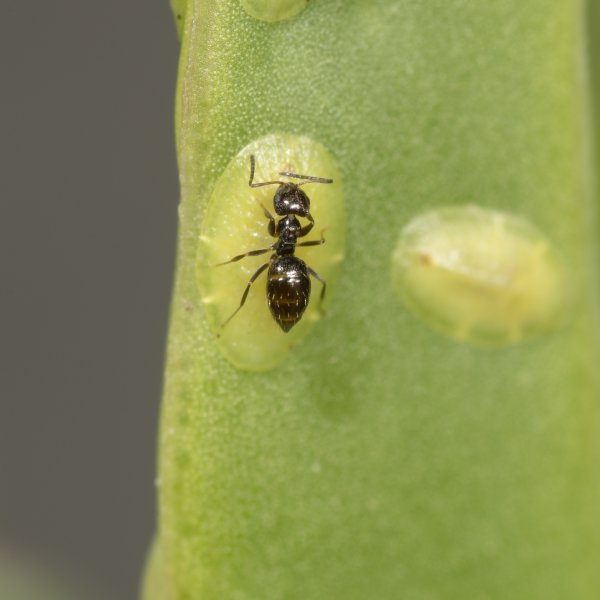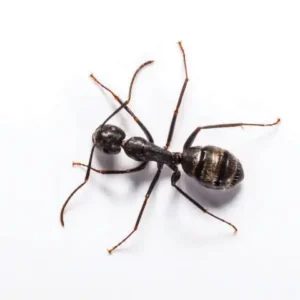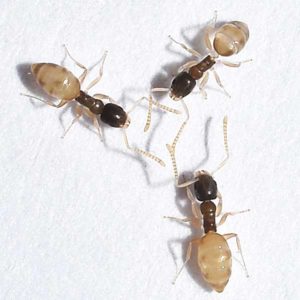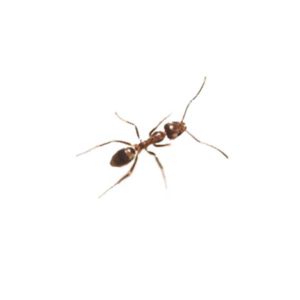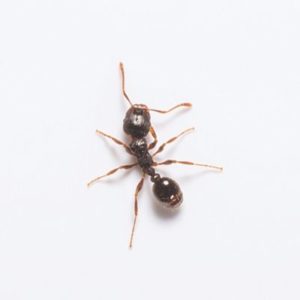Rover ants are an invasive insect originally from South America. Scientifically known as Brachymyrmex patagonicus, they have made themselves at home in Florida’s warm, humid climate. Although small, these ants can be problematic when they invade homes and commercial buildings. They can build multiple nests, reproduce quickly, and thrive in areas with high moisture levels.
Most people notice rover ants when they see them trailing along countertops or sinks, especially in kitchens and bathrooms. They can become a persistent pest and are often difficult to remove without professional help.
Characteristics
Rover ants are tiny, only about 1.5 to 2 mm long, and have a smooth, shiny body that ranges in color from light to dark brown or black. They have one node between their thorax and abdomen and a slightly humped back.
Unlike some ants, rover ants don’t emit a strong odor when crushed. Their colonies tend to be small and only contain one queen, although they can multiply rapidly. In common with other ant species, rover ant colonies can spread through budding. This is where a portion of the colony breaks off to start a new nest nearby. This can make an infestation harder to manage without proper treatment.
Identification
Their size and coloration are similar to many other ant species, which can make them difficult to identify; some homeowners have been known to confuse them with dirt specks. You’ll often see worker ants foraging in lines along walls, baseboards, or plumbing fixtures. Rover ants move slowly and are usually spotted near water and moisture.
Winged forms may appear indoors, especially in the warmer months, and can be mistaken for termites. If you’re unsure what kind of ant you’re dealing with, a pest control technician can confirm whether you’re looking at rover ants or something else.
Habitat
Rover ants often settle in damp or decaying spots, particularly where there’s excess moisture. They like to eat sweet, natural food sources like nectar, plant sap, and honeydew. Inside homes, they accumulate in bathrooms, under sinks, or near leaking fixtures. Equally, in commercial buildings, they will linger around restrooms, plumbing, and canteens. They’re especially drawn indoors during dry periods when food and water are scarce outside. Replacing water-damaged wood and quickly fixing leaks can help prevent infestations and nest build-up indoors.
Rover Ants in Florida
Rover ants in Florida are typically 2 mm long. The larger reproductive ants are often mistaken for flying termites; however, while they can be annoying, unlike termites, they don’t eat wood. In the Florida region you’re more likely to notice these ants from late spring through summer, when the reproductive ones take flight and start forming new colonies. In particular becoming a hassle in May to August. This seasonal behavior can disrupt outside activities, such as garden parties or barbecues, as swarms of flying rover ants force people to seek shelter inside.
Rover Ant Behaviors, Threats, or Dangers
Even though rover ants don’t sting, bite, or carry disease, they can become a big problem because of their rapid reproduction. In addition, since they are so tiny, they can spread without being noticed right away. As the name suggests, they are known for their extensive foraging and roaming habits and can venture far from their nests in search of food. So even if you take precautions to prevent infestations, your property could still be at risk. If you see signs of ant activity, it’s smart to call a professional ant exterminator to inspect and treat the issue at the source.
Are Rover Ants Hard to Get Rid of?
Once rover ants are indoors, removing them can be a challenge. Their nests are often tucked away in hard-to-reach areas like behind walls, beneath floors, or inside damp wood. Store-bought sprays and baits might deal with visible ants, but they usually don’t reach the main colony.
While DIY methods might help in the short term, they rarely solve the root cause. For more dependable rover ants control, it’s best to bring in a pest control technician who can locate the source and apply a targeted plan to stop the infestation from spreading.
How many Rover Ants count as an Infestation?
Seeing the occasional rover ant doesn’t always mean you have an infestation. But if you start noticing them daily, especially in different parts of the home or commercial property, it could indicate that a colony is already inside.
Don’t wait too long to act. These ants can spread quickly and, if left for long enough, will form new nests around your property. Our ant exterminators are trained to deal with any situation. They are familiar with ant behavior, so they can track their activity, find the source, and stop them from spreading before the colony grows out of control.
Need help with Rover Ants?
We'll call you! Leave your information below.
Frequently Asked Questions
How Can I Identify a Rover Ant?
Look out for tiny, dark-colored, and slow-moving ants around sinks, bathtubs, or behind baseboards – in other words, areas with high moisture. It’s difficult for property owners to identify ant species, since many have similar characteristics. Our experts, however, will know exactly what you’re dealing with for effective treatment and extermination.
Are Rover Ants Harmful?
Rover ants aren’t known to spread diseases or cause painful bites, but that doesn’t mean they’re harmless. Their fast-growing colonies can be hard to manage and are a particular nuisance with al fresco dining, where there are plenty of spills and excess debris to feed on.
What Attracts Rover Ants to my Home?
The biggest reason rover ants enter homes is moisture. Leaky pipes, wet wood, or poor ventilation can all bring these ants inside. They’ll also come inside looking for food, especially sugary spills or crumbs left in hard-to-reach places.
How Do Rover Ants Enter Homes?
Because of their size, rover ants can get in through cracks around windows, doors, and plumbing. Once inside, they search for wet areas to build nests. It’s common to find them in walls, behind tiles, or near damaged wood.
Are Rover Ants Active Year-Round?
In Florida’s climate, rover ants can stay active throughout the year, although their activity tends to peak from late spring into summer, when winged ants begin leaving the colony to start new ones. This is when homeowners are most likely to notice them indoors.

